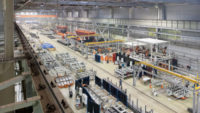Many people are not aware of that manufacturers are making considerable progress in reducing water consumption.
They are doing this not only because they may be in areas of the world suffering from chronic droughts or climate change, but because it is simply good business. The less water used, the less these industries must pay for water, and in some cases, the cost of water may be one of their most significant expenses.
Further, many of these industries can’t just return used water back to their local water companies to be treated and then reused. Wastewater from industrial locations is often heavily polluted. The pollution load, as it is termed, may be two or three times higher than household wastewater.
The industrial wastewater must be treated, which often requires the use of large amounts of chemicals, and disposed of in ways specified by local guidelines. This can be costly; once again, the less water used, the more savings for the organization.
While there are many additional reasons industrial locations are working to reduce water consumption, we must mention one more here: it is simply good PR.
Many organizations are now actively working to improve community relations and prove to their neighbors, vendors, and customers that they are striving to be environmentally sensitive and promote sustainability. Reducing water consumption is one way they are accomplishing this.
Exactly how are industrial facilities reducing water consumption?
Changing employee behaviors. Many facilities, just like many of us, are accustomed to indiscriminately using water. We pay little attention to the amounts we use because water is inexpensive and has always been readily accessible. Many organizations are working with their staff — even creating training programs — to discuss the importance of reducing water consumption and provide them ways to do so.
Benchmarking consumption. Many facilities have no idea how much water they are consuming. Further, they may not know if one division in a facility uses more water than another and by how much. Administrators must know how much water they are currently using before they can start saving water. To determine consumption, it is a wise idea to invest in submetering. These water meters, placed in different plant areas, indicate how much water a specific area is consuming.
Analyze the bill. Along with benchmarking water consumption, water utility bills should be analyzed and understood. Some utility bills are quite complicated. Make sure you know how the bill is tabulated. Also, water utility bills should always be delivered to the operations officer first and not accounts payable. The accounting staff just pays the bill; the operations officer examines the bill per the discussed parameters.
Prizes and incentives. Many large organizations have different divisions within the same plant. Some administrators award prices and provide other types of incentives to those divisions that have reduced water consumption within a certain period. These competitions, according to one administrator, are surprisingly effective.
Put staff in charge. Most water used in an industrial facility is typically on the plant floor. It is not in the offices and certainly not in the C-suite. Because of this, many administrators are asking their staff to lead the way when it comes to reducing water consumption. They are using the water; they can learn to save water.
Minimizing the use of water for cleaning. In an industrial location, large amounts of water are often used to clean the facility. Hosing floors should be avoided. Instead, consider indoor-pressure cleaning systems. The high pressure does more of the work, helping to loosen and remove soils so that less water is needed. Also, if possible, minimize the amount of exterior washing of the facility, including parking lots and the actual building. Switch regular window cleaning schedules to as needed schedules. Reducing cleaning frequency saves water.
Check restroom fixtures. In a typical office building, it is not unusual that the restrooms use most of the facility’s water. While this may not be true in an industrial setting, we know that high volumes of water are still consumed in those restrooms. Evaluate the restroom fixtures in use.
If they are more than a few years old, consider transferring all to “high efficiency” fixtures. As it pertains to urinals, no-water urinal technology can result in a dramatic reduction in water consumption.



